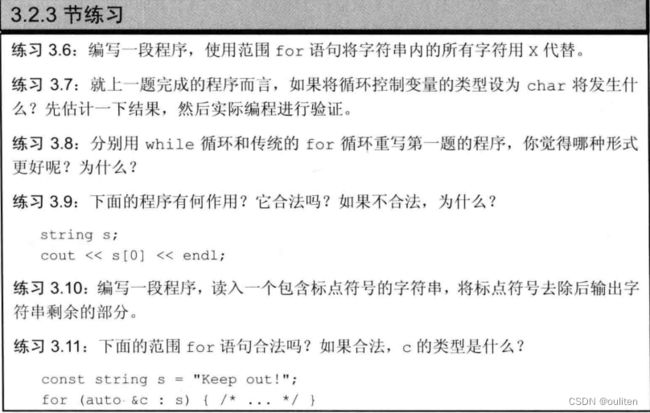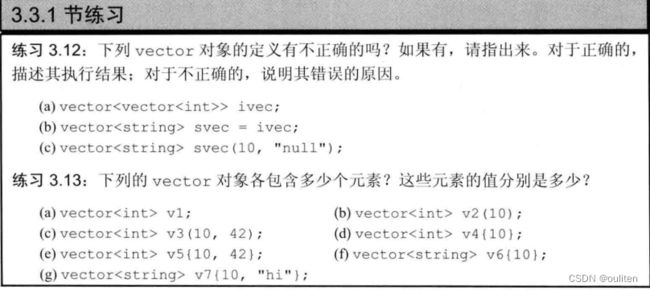《Primer C++》第五版习题:第三章
3.1
这个题就是让你加个using namespace std;这样就不用写很多std::了
3.2
int main(){
string str;
while(getline(cin,str));//这是读入一行
//while(cin>>str); 这个是读入一个单词
return 0;
}3.3
cin遇到空白字符会停止读取,空白字符还在缓冲区。
getiline会读入空白字符,但是最后会把它丢弃,不会存到string里去。
3.4
int main()
{
string s1, s2;
cin >> s1 >> s2;
bool result = s1 == s2;
if (result) { cout << "相等"; }
else { cout << max(s1, s2); }
return 0;
}int main()
{
string s1, s2;
cin >> s1 >> s2;
bool result = s1.length() == s2.length();
if (result) { cout << "等长"; }
else { cout << (s1.length()>s2.length()?s1:s2); }//用了三目运算符
return 0;
}3.5
int main()
{
string s,catstring="";
while (cin>>s)
{
catstring += s;
//catstring+=" "; 多个空格分割
}
return 0;
}3.6
int main()
{
string str = "abcdefg";
for (auto& c : str) {//一定要写成引用
c = 'X';
}
}3.7
这个问题感觉没说明白。
如果写成for(char &c:str)的话,结果是一样的;不过不加&只是char c,也就不是引用的话就不对了,这样的话str是没有变化的。
3.8
int main()
{
string str = "abcdef";
int i = 0;
while (i != str.size()) {
str[i]='X';
i++;
}
}int main()
{
string str = "abcdef";
for (int i = 0; i < str.size(); i++)
str[i] = 'X';
}其实都差不多了
3.9
虽然不会报错,但是通常会导致程序崩溃或产生不可预测的结果。尽量不要这样做
3.10
int main()
{
string str;
getline(cin, str);
for (auto c : str)
if (!ispunct(c))
cout << c;
}3.11
不合法,因为auto不会保留顶层const,如果在for循环里改变c会报错。
3.12
(a)正确,是一个空的容器
(b)错误,svec与用来初始化的ivec类型不同
(c)正确,是一个字符串的容器,里面有10个元素,都是"null"
3.13
(a) 0
(b) 10个0
(c) 10个42
(d) 1个10
(e) 2个 10和42
(f) 10个空字符串
(g) 10个"hi"字符串
3.14
int main()
{
vector vec;
int i;
while (cin >> i) {
vec.push_back(i);
}
return 0;
} 3.15
int main()
{
vector vec;
string str;
while (getline(cin,str)) {
vec.push_back(str);
}
return 0;
} 3.16
我就不一个一个容器的输出了,写一个函数吧,把容器传过来然后就输出
void put(const vector& vec) {//当然,这只能输出int容器
for (const auto& item : vec)
cout << item;
} 3.17
int main()
{
vector vec;
string str;
while (cin >> str)
vec.push_back(str);
for (auto& s : vec) {
for (auto& c : s) {
c = toupper(c);//通过这个函数改变每个字符的大小,定义在cctype头文件里
}
}
for (const auto& s : vec)//改完然后输出
cout << s << endl;
} 3.18
不合法,ivec是一个空的容器,还没有第一个元素
应该改成
vector ivec;
ivec.push_back(42); 3.19
int main()
{
vector vec1(10, 42);
vector vec2(10);
for (int i = 0; i < 10; i++)
vec2[i] = 10;
vector vec3;
for (int i = 0; i < 10; i++)
vec3.push_back(10);
} 第一种方式更好,它是构造的时候就定好了。其他两种情况容器一开始都是默认初始化的情况。
3.20
int main()
{
vector vec;
int x;
while (cin >> x)
vec.push_back(x);
int n = vec.size();
for (int i = 0; i < n - 1; i++)
cout << vec[i] + vec[i + 1]< int main()
{
vector vec;
int x;
while (cin >> x)
vec.push_back(x);
int n = vec.size();
for (int i = 0,j=n-1; i<=j; i++,j--)
cout << vec[i] + vec[j]< 3.21
同样也是写个函数吧
void put(const vector& vec) {
for (auto it = vec.cbegin(); it != vec.cend(); it++)
cout << *it;
} 3.22
int main()
{
vector vec;
string str;
while (cin >> str)
vec.push_back(str);
for (auto& s : vec) {
for (auto it = s.begin(); it != s.end();it++) {//其实就是范围for改成迭代器遍历
*it = toupper(*it);//通过这个函数改变每个字符的大小,定义在cctype头文件里
}
}
for (const auto& s : vec)//改完然后输出
cout << s << endl;
} 3.23
int main()
{
vector vec(10, 5);
for (auto it = vec.begin(); it != vec.end(); it++) {
*it *= 2;
cout << *it;
}
} 3.24
int main()
{
vector vec;
int x;
while (cin >> x)
vec.push_back(x);
int n = vec.size();
for (auto it = vec.begin(); it != vec.end() - 1; it++)
cout << *it + *(it + 1) << endl;
} int main()
{
vector vec;
int x;
while (cin >> x)
vec.push_back(x);
int n = vec.size();
for (auto it = vec.begin(),it2=vec.end()-1; it<=it2; it++,it2--)
cout << *it + *it2 << endl;
} 3.25
vector scores(11, 0);
unsigned grade;
while (cin >> grade) {
if (grade <= 100)
(*(scores.begin() + grade / 10))++;//要再套一层括号,因为++优先级高于*,得先用*取得对应的引用
} 3.26
begin+end可能溢出没有意义。
后面的内容都是C里面的数组了,我的评价是略过







